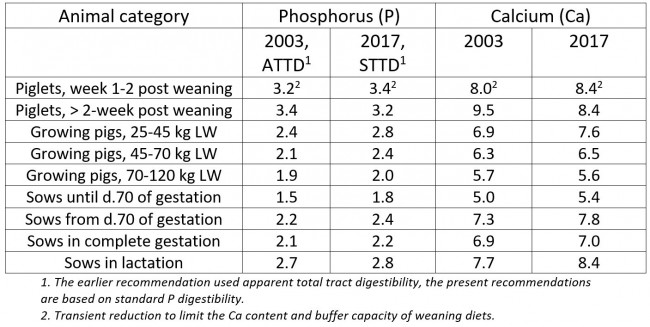Until recently, when discussing phosphorus and calcium requirements for pigs many feed producers and swine farmers turned to the study Phosphorus Standards for Pigs: 2003 review as their ‘go to’ source of information. In a sea of data on animal nutrition, for the last 16 years this piece of research by Jongbloed, van Diepen, and Kemme has been the definitive study on the subject…until now.
This is because a study by researchers from Wageningen University that was published in May 2018 is increasingly being seen as the new leading light on the topic.
The study, entitled Phosphorus and Calcium Requirements of Growing Pigs and Sows, presents a full analysis of the effects of phosphorus and calcium levels and reports on the ‘sweet spot’ requirements.
Phosphorus and Calcium Requirements for Pigs
Researched by Machiel Blok and Paul Bikker, from the university’s Department of Animal Nutrition, the study was conducted to gain an enhanced understanding of the ideal levels of phosphorus and calcium in a pig’s body through the different stages of its life. The analysis was necessary due to the rapid development of livestock farming since the 2003 study. This included new scientific methods and data, as well as changes in pig farming.
Changes in the genotypes of modern pigs mean that their genetic capabilities have also changed. From improved feed efficiency, to body gain, to piglet production, today’s pigs are genetically different, with different nutritional needs. Dietary requirements are constantly evolving as the industry also evolves.
With such a high standard set by previous research, the Bikker and Blok needed to be thorough, as well as basing their findings on multiple data sources. As the Wageningen University website reports, the study was, “… based on the endogenous losses of Ca and P in faeces and urine, the retention in the body of growing pigs, in maternal and foetal tissues and milk in sows, and the efficiency of the processes involved. The requirements have now been expressed on a standardised digestible basis in which basal endogenous losses are regarded as part of the maintenance requirements of the pigs. As a consequence, these recommendations need to be used in combination with the standardised digestible P content of feed materials and diets.”
The study also takes into account modern environmental concerns to limit phosphorus run-off that may not have been considered so deeply in earlier analysis.
Just as the accuracy and influence of previous studies have also faded with time, so too will the findings in this latest work. The constantly changing face of modern farming and modern pig breeds means that no single study can ever be the last word on phosphorus and calcium in swine.
However, this study still presents the ideal levels of P and Ca in pigs throughout an animal’s life (in comparison to the 2003 Jongbloed et al. analysis) to be as follows:

Data source: Wageningen University
AG CHEMI GROUP has been supplying animal feed additives, including monocalcium phosphate, since 1994.

If you are interested in buying monocalcium phosphate, or would like to know more about animal feed raw materials, then please contact the friendly, multi-lingual sales team, or take a look at the AG CHEMI GROUP catalogue.
Photo credit: Martinslibrary, Sciencestruck, & Thelearnedpig Pexels